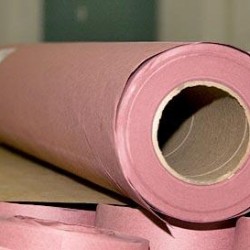Red Rosin Paper for Installing Floors
After you’ve got a good, smooth, stable subfloor and underlayment, the last step before installing the finish flooring–red rosin paper.
This stuff mystified me the first time I saw it installed. I thought: Isn’t there anything better to lay down as a moisture barrier? Well, for one thing, you don’t want an absolutely impermeable moisture block–otherwise, you could just lay down sheet plastic, right?
If you don’t want to read the rest of this article, the upshot is this: red rosin paper is a perfectly acceptable type of protective layer to use for installing wood floors. But for some details, read on:
Is Red Rosin Paper Waterproof?

No, and it doesn’t pretend to be waterproof.
Red rosin paper has certain “breathability” attributes that you need for wood flooring, because wood flooring needs to breathe, too. If you’re worried that red rosin paper is just plain old paper, it’s not. Rosin, after all, is derived from resin, the pitch that comes from pine trees and has long been used as a waterproofing material.
What About Builder’s Felt?
Still, why use it? Even some professional floor installers question whether red rosin paper is the best protective surface to us, many preferring instead to use good old 15 lb. builder’s felt. Since floor installers bear the costs of the protective layer, it’s in their best interest to use something that is cost-effective, and red rosin paper certainly is. The 15 lb. builder’s felt isn’t much more expensive, though installers say that it’s not much more of a moisture barrier than the red rosin.
The consensus is that whether red rosin paper or builder’s felt, the purpose is to slow the passage of moisture. After all, you’re peppering the subfloor with about 9 million nails, how can you truly make it waterproof anyway?